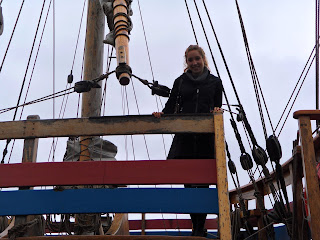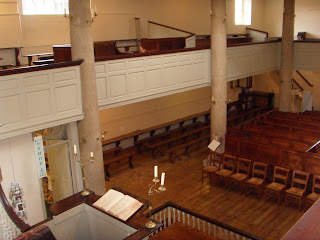
In university, my American history professor would lament the common writing mistakes undergraduates would make. He would admonish us to never, EVER begin a paper with the phrase "Since the beginning of time." It was trite, it was treacly, it was melodramatic and sweeping and outlandish. It was his number one rule, followed by his second commandment: thou shalt not use Wikipedia as a source (and if you MUST, thou shalt not have the shamelessness/stupidity to admit it).
Well, today I'm going to blatantly flout both of his cardinal rules. After all, I'm no longer a history undergrad, right? I'm going to live on the edge a bit. And rules, sometimes, are meant to be broken.
So, without further ado...
Since the beginning of time, humans have questioned who we are, why we're here, if and how and when we were put on this earth, and by whom, if anyone. Some people have called this search for the Other "God", and attempts have been made throughout history to find ways of personifying this Other, of becoming closer to Him, of honouring Him, of understanding Him even when we have a sort of desperate knowledge of the futility of grasping something much, much bigger than us.
One of the ways this search for answers can be exteriorized is through the medium of architecture. And what better way to reach for the heavens than through spectacular, sky-soaring cathedrals?
Men built cathedrals for a myriad of complex reasons, it is true - not entirely altruistic ones, either. Bishops and kings and rulers have naturally wanted to showcase their earthly power, and if they managed to appease the Big Guy Upstairs at the same time, well, all the better. But one cannot ignore the spiritual motivations that lay behind a cathedral's heavy stone walls, that desire to define and glorify the Other in a physical, real manner that we can understand. Some people scoff at beautiful religious buildings, wondering why so much money has been spent on a
structure, for goodness sake, when there are homeless, hungry people in the world. I don't have an answer to this. Does anyone? All I know is that when I stood in front of Wells Cathedral, the seat of the Diocese of Bath and Wells, I
understood. I understood why someone might be compelled, inspired, moved to build an enormous homage to God, a building that transcends the earthly kingdom that everyone was used to, and tries to reach the heights of heaven, that kingdom that was the focus of everyone's aspirations. Breath-taking, moving, magnificent, stunning...these words all come to mind when you stand facing the western side of Wells Cathedral.
It doesn't matter if you believe in God, or how you choose to worship Him, if you're Christian or Jewish or Muslim. Wells Cathedral cannot fail to impress you. Construction on the present cathedral was started shortly before 1184, but the grounds upon which it is built have been a religious site for millenia. Long before the birth of the man called Jesus of Nazareth, pagan Brits worshiped the site because of its three wells that had sprung up. The Romans also used the land for religious purposes, and in 705 CE the first church was established by King Ine of Wessex. When I learned this (and yes, I first read about this on Wikipedia, the night before we left for Wells in an attempt to cram in some knowledge!), I was stunned. My church back home in Canada recently celebrated its hundredth anniversary, and I thought
that was old. Europe is a whole new ball game, it appears.
 In the garden of the Lady Chapel at
In the garden of the Lady Chapel at
Wells Cathedral
The Cathedral of Wells dominates the landscape of this city, the smallest city in England (population 10, 406; it has had city status since 1205). Wells may not be on the Top 10 List for tourists traveling to England, but what a great idea to add it! Yes, it is a little "off the beaten track" but that is EXACTLY why you should check it out. It is also 20-30 minutes away from Bristol, Bath, Glastonbury, Cheddar, and Weston-Super-Mare - all fascinating, historically significant places to explore in their own right.
 Standing by the Cheddar Gorge, where
Standing by the Cheddar Gorge, where
cheddar cheese was invented and kept in the
caves for a distinctive flavour!
Wells Cathedral has been described as the "most poetic of English cathedrals." For any history buffs/Ken Follett fans out there, it served as the inspiration for his amazing "Pillars of the Earth" novel, and was used as the completed Kingsbridge Cathedral at the end of the 2010
Pillars of the Earth miniseries! Having read this book, I found that my experience at Wells Cathedral was amplified. I am no architecture aficionado in the slightest, but the book gave me a foundation (pun intended) to better appreciating the marvels of the cathedral.
 The unique "scissor arches": a brilliant solution
The unique "scissor arches": a brilliant solution
to crumbling foundations by master mason
William Joy in 1338!
I could write an entire paper on this cathedral (although I doubt I would get a decent mark on it, thanks to my sweeping opening statement!) but I don't want to bore anyone. There are fascinating and compelling stories within these walls, such as the murder of Sir Walter Raleigh's nephew, the pre-Copernican (back when everyone thought the earth was the centre of the universe) astronomical clock, the 300 figures of statuary on the west side of the cathedral, beginning with Jesus at the very top and his 12 disciples underneath, the Lady Chapel and the Chapter House, the medieval brasses that were sold off by Henry VIII during the English Reformation and the Dissolution of the Monasteries...when you begin to consider just how much history this cathedral has seen in its thousand year life, you are completely staggered.
 A bit of Russia in rural England: an icon
A bit of Russia in rural England: an icon
painted by a Russian artist depicting Saint
Andrew, the patron saint of the Cathedral.
The actual city of Wells is so much more than its cathedral, however. It is not a sleepy little English city, but a busy, bustling hub. There was an open market in the town square yesterday, where vendors were selling everything from fresh veggies to homemade cheddar cheese (invented in Cheddar, just a 10 minute drive away!) and fresh cider (the Somerset area is famous for its cider, which, by the way, is alcoholic and not at all like the "warm apple juice" I was under the delusion of believing it to be!). There are pubs everywhere, shops and winding, twisting cobble-stoned streets. Yesterday was the hottest October 1 in Britain on record, and everyone was out and about enjoying the gorgeous weather. The night before, Liz, Ian and I had watched "Hot Fuzz", a movie that was filmed in Wells, so it was a lot of fun standing in a particular spot and saying, "Oh, this is where they had the shoot-out!" (Wells is also where part of the Cate Blanchett
Elizabeth: the Golden Age movie was filmed).

Another highlight of Wells is Vicars' Close, the oldest residential street in Europe. Unfortunately by this time my camera battery had died a slow death due to my constant picture-taking, but take my word when I recommend exploring this street! It tapers at the end by ten metres in order to create an optical illusion - it looks longer from one end, shorter from the other.
Since I've already broken the "history student guidelines to writing a good paper", I won't bother to write a long conclusion that sums up all my arguments and points and states my thesis in a new and exciting way (how many times can one rely on thesaurus.com, anyway?) I'll keep it short and sweet: Wells is a beguiling, captivating, and delightful place. The cathedral will literally make you lose your breath as you cran your neck in an attempt to look at everything and marvel at the human hands who built it.
 Back in his hometown after 14 months:
Back in his hometown after 14 months: In front of the Spanish Arch, built in 1584.
In front of the Spanish Arch, built in 1584. "The tea doesn't care who may drink it":
"The tea doesn't care who may drink it": Lynch's Castle - where legend has it that
Lynch's Castle - where legend has it that Yes, the sun does come out in Ireland, and the effect
Yes, the sun does come out in Ireland, and the effect County Clare in the background
County Clare in the background The art of the perfect pour: waiting for our
The art of the perfect pour: waiting for our










































